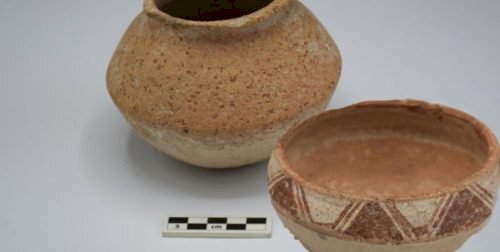3,000-year-old earthenware discovered in southern Iran

TEHRAN - Local people in a southern Iranian village have accidentally discovered two pieces of earthenware, estimated to date from the Proto-Elamite period, some 3,000 years ago.
The relics were unearthed when people were digging the ground to install curbs for a sidewalk in the village of Golmakan, Marvdasht county.
“According to cultural heritage experts, the clay objects date from the Old Elam (Banash),” CHTN quoted Marvdasht’s tourism chief, Mohammad-Taqi Qalenoei, as saying on Wednesday.
“These objects comprise a clay bowl with geometric designs in the form of a triangle on the edge with a height of about 10 cm, and a simple pot, which was probably used to store spices and special liquids, “ the official explained.
Having a rich history, Marvdasht has been settled for a long time during various eras, including the Elamite, Achaemenid, Sassanid, and Islamic periods… and it embraces important archaeological sites such as Persepolis, Naqsh-e Rostam, Naqsh-e Rajab, Tal-e Bakun, Mian Roud, and Ashkeft Gavi to name a few, he said.
According to Iranica, the archeological use of the term Elam is based on a loose unity recognizable in the material cultures of the period 3400-525 BC. Elamite culture can be traced in Susa, which is situated in Khuzestan, in Anshan of Fars, and sites in adjacent areas of the Zagros mountains, particularly in the modern provinces of Lorestan, Kordestan, and Kerman.
Experts believe that Elam was distinct from the contemporary civilizations of Sumer and the Indus valley in the episodic cultural and political integration of large expanses of geographically diverse territory. The lines of communication between Susa and Anshan, the largest cities of Elam, as well as with other, more distant mountain regions, were limited in number and generally difficult, owing to the rugged topography.
Proto-Elamite (Susa III/Banesh) period, ca. 3400/3200-2800 BC was characterized by a distinctive assemblage of artifacts and an artistic style distributed from Lorestan in the west to Kerman in the east.
Furthermore, the establishment of a city at Anshan during the Proto-Elamite period and smaller outposts at Tepe Sialk and Tepe Yahya in the eastern highlands suggest that the foundations of the union between lowland and highland regions characteristic of later Elam were first laid in the late 4th millennium.
The ecosystem of the Marvdasht plain, which was once the seat of power for the Achaemenid Persian Empire (c. 550 – 330 BC), has been one of the most important factors in the creation and development of several thousand years of civilization in this region. That is why the remains of different settlements and cultures have been discovered during many excavations carried out in ancient hills and historical sites of the plain, cultural heritage expert Hamid Fadaei says.
The ancient region, known as Pars (Fars), or Persis, was the heart of the Achaemenid Empire founded by Cyrus the Great and had its capital at Pasargadae. Darius I the Great moved the capital to nearby Persepolis in the late 6th or early 5th century BC. Alexander the Great defeated the Achaemenian army at Arbela in 331 and burned Persepolis, apparently as revenge on the Persians, because it seems the Persian King Xerxes had burnt the Greek City of Athens around 150 years earlier.
Persis became part of the Seleucid kingdom in 312 after Alexander’s death. The Parthian empire (247 BC– 224 CE) of the Arsacids (corresponding roughly to the modern Khorasan in Iran) replaced the Seleucids’ rule in the Persis during 170–138 BC. The Sasanid Empire (224 CE–651) had its capital at Istkhr. Not until the 18th century, under the Zand dynasty (1750–79) of southern Iran, did Fars again become the heart of an empire, with its capital at Shiraz.
AM
Leave a Comment